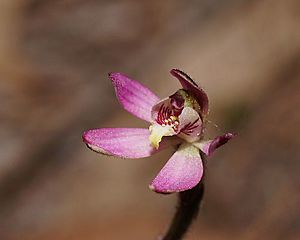Tiny fingers facts for kids
Quick facts for kids Tiny fingers |
|
|---|---|
 |
|
| Caladenia pusilla in Langwarrin flora and fauna reserve | |
| Scientific classification | |
| Genus: |
Caladenia
|
| Species: |
pusilla
|
| Synonyms | |
|
Petalochilus pusillus (W.M.Curtis) D.L.Jones & M.A.Clem. |
|
The Caladenia pusilla, often called tiny fingers, pygmy caladenia, or pink fingers, is a special type of orchid plant. It grows naturally in Australia and New Zealand. This ground orchid has a single, slightly hairy leaf that stands up straight. It also has one pink flower with a brownish-pink back. These flowers don't last long and can pollinate themselves.
Contents
What Does Tiny Fingers Look Like?
The Tiny Fingers orchid is a plant that lives for many years. It grows from an underground tuber (like a small potato). Each plant has one leaf that stands up straight. This leaf is about 30–60 mm (1.2–2.4 in) long and 10–15 mm (0.39–0.59 in) wide. It has a few hairs on it.
A single flower grows on a stem that is 40–100 mm (1.6–3.9 in) tall. The flower itself is about 50–80 mm (2.0–3.1 in) long and 80–100 mm (3.1–3.9 in) wide. It is usually pink with a brownish-pink back. Sometimes, it has a white center.
The top part of the flower, called the dorsal sepal, is 50–70 mm (2.0–2.8 in) long. It stands up at the bottom but then curves forward. The two side parts, called lateral sepals, are also 50–70 mm (2.0–2.8 in) long. They are partly joined together. The petals are 50–60 mm (2.0–2.4 in) long and spread out wide.
The special lip of the flower, called the labellum, is white or pink. It has red lines on it and is about 4–5 mm (0.16–0.20 in) long and wide. The sides of the labellum might have small teeth near the end, which curls under. There are also two rows of yellow-headed bumps along the middle of the labellum.
These orchids bloom from September to November. However, their flowers only stay open for a day or two. Sometimes, they barely open at all. They can pollinate themselves, meaning they don't need insects to help them make seeds.
Naming the Tiny Fingers Orchid
The Caladenia pusilla was first officially described in 1980. A scientist named Winifred Curtis wrote about it after finding a sample on King Island. The name pusilla comes from a Latin word. It means "very small," "little," or "pretty."
Where Does Tiny Fingers Grow?
This orchid can be found in many places, but it grows in specific areas. In Victoria, Australia, it often grows in moist, coastal areas with low-growing plants. Sometimes, it can also be found in forests further inland.
In New South Wales, it grows in the southern parts, starting from near Wellington. In South Australia, you can find it in the southeastern corner. This includes places like the Yorke Peninsula and Kangaroo Island. In Tasmania, it grows along the coast, including on King and Flinders Islands. In New Zealand, it lives in scrubland on the North Island.
Protecting Tiny Fingers
The Caladenia pusilla orchid is considered "rare" in Tasmania. This means there are not many of them left. The Tasmanian Government has a law called the Threatened Species Protection Act 1995. This law helps protect plants and animals that are rare or in danger.

